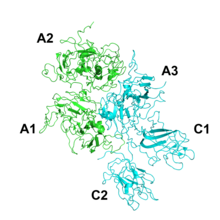 A depiction of factor VIII | |
| Clinical data | |
|---|---|
| Trade names | Aafact, Kovaltry, others[1] |
| Other names | octocog alfa |
| AHFS/Drugs.com | Monograph |
| License data | |
| Routes of administration | Intravenous (IV) |
| ATC code | |
| Legal status | |
| Legal status | |
| Identifiers | |
| ChemSpider |
|
| Clinical data | |
|---|---|
| Trade names | Adynovi |
| ATC code |
|
| Legal status | |
| Legal status |
|
| Clinical data | |
|---|---|
| Trade names | Advate |
| ATC code |
|
| Legal status | |
| Legal status |
|
Factor VIII is a medication used to treat and prevent bleeding in people with hemophilia A and other causes of low factor VIII.[10][11] Certain preparations may also be used in those with von Willebrand's disease.[11] It is given by slow injection into a vein.[10]
Side effects include skin flushing, shortness of breath, fever, and red blood cell breakdown.[10][11] Allergic reactions including anaphylaxis may occur.[11] It is unclear if use during pregnancy is safe for the fetus.[12] A purified factor VIII concentrate is made from human blood plasma.[11] A recombinant version is also available.[10] People may develop antibodies to factor VIII such that this medication becomes less effective.[12]
Factor VIII was first identified in the 1940s and became available as a medication in the 1960s.[13][14] Recombinant factor VIII was first made in 1984 and approved for medical use in the United States in 1992.[15][16] It is on the World Health Organization's List of Essential Medicines.[17]
- ^ "Coagulation Factor VIII, Human". www.drugs.com. Archived from the original on 9 January 2017. Retrieved 8 January 2017.
- ^ "Prescription medicines: registration of new chemical entities in Australia, 2017". Therapeutic Goods Administration (TGA). 21 June 2022. Retrieved 9 April 2023.
- ^ "Prescription medicines: registration of new chemical entities in Australia, 2016". Therapeutic Goods Administration (TGA). 21 June 2022. Retrieved 10 April 2023.
- ^ "Prescription medicines: registration of new chemical entities in Australia, 2014". Therapeutic Goods Administration (TGA). 21 June 2022. Retrieved 10 April 2023.
- ^ "Prescription medicines and biologicals: TGA annual summary 2017". Therapeutic Goods Administration (TGA). 21 June 2022. Retrieved 31 March 2024.
- ^ "Regulatory Decision Summary for Alphanate". 23 October 2014.
- ^ "Health Canada New Drug Authorizations: 2016 Highlights". Health Canada. 14 March 2017. Retrieved 7 April 2024.
- ^ "Adynovi EPAR". European Medicines Agency. 8 January 2018. Retrieved 20 June 2024.
- ^ "Advate EPAR". European Medicines Agency. 2 March 2004. Retrieved 20 June 2024.
- ^ a b c d World Health Organization (2009). Stuart MC, Kouimtzi M, Hill SR (eds.). WHO Model Formulary 2008. World Health Organization. pp. 259–60. hdl:10665/44053. ISBN 9789241547659.
- ^ a b c d e British National Formulary : BNF 69. British Medical Association. 2015. p. 171. ISBN 978-0857111562.
- ^ a b "Alphanate – Summary of Product Characteristics (SPC) – (eMC)". www.medicines.org.uk. Archived from the original on 9 January 2017. Retrieved 8 January 2017.
- ^ Potts DM (2011). "Chapter 5". Queen Victoria's Gene: Haemophilia and the Royal Family. The History Press. ISBN 978-0752471969. Archived from the original on 9 January 2017.
- ^ High KA (2012). "In vivo characteristics of rDNA Factor VIII: The impact for the future in hemophilia care". In Sibinga CS, Das PC, Overby LR (eds.). Biotechnology in blood transfusion: Proceedings of the Twelfth Annual Symposium on Blood Transfusion, Groningen 1987, organized by the Red Cross Blood Bank Groningen-Drenthe. Springer Science & Business Media. p. 224. doi:10.1007/978-1-4613-1761-6_19. ISBN 978-1461317616. Archived from the original on 9 January 2017.
- ^ Brownlee GG, Giangrande PL (2012). "Clotting factors VIII and IX". In Buckel P (ed.). Recombinant Protein Drugs. Birkhäuser. p. 79. ISBN 978-3034883467. Archived from the original on 9 January 2017.
- ^ Zimring JC, Duncan A (2006). "Chapter 25 - Coagulation Factor Preparations". In Hillyer CD (ed.). Blood Banking and Transfusion Medicine: Basic Principles & Practice. Elsevier Health Sciences. p. 353. doi:10.1016/B978-0-443-06981-9.50030-2. ISBN 0443069816. Archived from the original on 9 January 2017.
- ^ World Health Organization (2019). World Health Organization model list of essential medicines: 21st list 2019. Geneva: World Health Organization. hdl:10665/325771. WHO/MVP/EMP/IAU/2019.06. License: CC BY-NC-SA 3.0 IGO.